Numerical Modelling of Dispersed Water in Oil Flows Using Eulerian-Eulerian Approach and Population Balance Model
Abstract
:1. Introduction
2. Numerical Model
2.1. Governing Equations for the Model
2.2. Interfacial Forces
2.3. Population Balance Model
2.4. Turbulence Model
3. Geometry and Boundary Conditions
4. Results and Discussions
5. Conclusions
Author Contributions
Funding
Conflicts of Interest
Nomenclature
| Density of continuous phase | |
| Volume fraction of continuous phase | |
| Velocity of continuous phase | |
| Interfacial force exterted on continuous phase | |
| Viscosity of continuous phase | |
| Drag force | |
| Lift force | |
| Turbulent dispersion force | |
| Virtual mass force | |
| Drag coefficient | |
| Volume fraction of dispersed phase | |
| Eotvos number | |
| Re | Reynolds number |
| Diameter of dispersed phase | |
| Surface tension | |
| Lift force coefficient | |
| Turbulent dispersion force coefficient | |
| Turbulent kinetic energy of continuous phase | |
| Virtual mass force coefficient | |
| Birth rate due to breakup | |
| Death rate due to breakup | |
| Birth rate due to coalescence | |
| Death rate due to coalescence | |
| Breakup rate | |
| Coalescence rate | |
| Collision frequency | |
| We | Weber number |
| D | Pipe diameter |
| Turbulent intensity | |
| x | Diameter ratio |
| Mixture density | |
| Number of droplets of size n | |
| Density of dispersed phase | |
| Velocity of dispersed phase |
References
- Angeli, P.; Hewitt, G.F. Flow structure in horizontal oil–water flow. Int. J. Multiph. Flow 2000, 26, 1117–1140. [Google Scholar] [CrossRef]
- Ahmed, S.A.; John, B. Liquid–Liquid horizontal pipe flow–A review. J. Pet. Sci. Eng. 2018, 168, 426–447. [Google Scholar] [CrossRef]
- Xu, X.X. Study on oil-water two phase floe in pipelines. J. Pet. Sci. Eng. 2007, 59, 43–58. [Google Scholar] [CrossRef]
- Lovick, J.; Angeli, P. Experimental studies on the dual continuous flow pattern in oil–water flows. Int. J. Multiph. Flow 2004, 30, 139–157. [Google Scholar] [CrossRef]
- Kumara, W.A.S.; Halvorsen, B.M.; Melaaen, M.C. Pressure drop, flow pattern and local water volume fraction measurements of oil–water flow in pipes. Meas. Sci. Technol. 2009, 20, 114004. [Google Scholar] [CrossRef]
- Yusuf, N.; Al-Wahaibi, Y.; Al-Wahaibi, T.; Al-Ajmi, A.; Olawale, A.S.; Mohammed, I.A. Effect of oil viscosity on the flow structure and pressure gradient in horizontal oil–water flow. Chem. Eng. Res. Des. 2012, 90, 1019–1030. [Google Scholar] [CrossRef]
- Ismail, A.S.I.; Ismail, I.; Zoveidavianpoor, M.; Mohsin, R.; Piroozian, A.; Misnan, M.S.; Sariman, M.Z. Review of oil–water through pipes. Flow Meas. Instrum. 2015, 45, 357–374. [Google Scholar] [CrossRef]
- Prieto, L.; Muñoz, F.; Pereyra, E.; Ratkovich, N. Pressure gradient correlations analysis for liquid-liquid flow in horizontal pipes. J. Pet. Sci. Eng. 2018, 169, 683–704. [Google Scholar] [CrossRef]
- Boxall, J.A.; Koh, C.A.; Sloan, E.D.; Sum, A.K.; Wu, D.T. Droplet size scaling of water-in-oil emulsions under turbulent flow. Langmuir 2011, 28, 104–110. [Google Scholar] [CrossRef] [PubMed]
- Zhang, H.; Lan, H.Q. A review of internal corrosion mechanism and experimental study for pipelines based on multiphase flow. Corros. Rev. 2017, 35, 425–444. [Google Scholar] [CrossRef]
- Apte, M.S.; Matzain, A.; Zhang, H.Q.; Volk, M.; Brill, J.P.; Creek, J.L. Investigation of paraffin deposition during multiphase flow in pipelines and wellbores—Part 2: Modeling. J. Energy Resour. Technol. 2001, 123, 150–157. [Google Scholar] [CrossRef]
- Sarica, C.; Panacharoensawad, E. Review of paraffin deposition research under multiphase flow conditions. Energy Fuels 2012, 26, 3968–3978. [Google Scholar] [CrossRef]
- Akhfash, M.; Aman, Z.M.; Ahn, S.Y.; Johns, M.L.; May, E.F. Gas hydrate plug formation in partially-dispersed water–oil systems. Chem. Eng. Sci. 2016, 140, 337–347. [Google Scholar] [CrossRef]
- Sohn, Y.H.; Kim, J.; Shin, K.; Chang, D.; Seo, Y.; Aman, Z.M.; May, E.F. Hydrate plug formation risk with varying water cut and inhibitor concentrations. Chem. Eng. Sci. 2015, 126, 711–718. [Google Scholar] [CrossRef]
- Danielson, T.J. Transient multiphase flow: Past, present, and future with flow assurance perspective. Energy Fuels 2012, 26, 4137–4144. [Google Scholar] [CrossRef]
- Paolinelli, L.D.; Rashedi, A.; Yao, J.; Singer, M. Study of water wetting and water layer thickness in oil-water flow in horizontal pipes with different wettability. Chem. Eng. Sci. 2018, 183, 200–214. [Google Scholar] [CrossRef]
- Gao, H.; Gu, H.Y.; Guo, L.J. Numerical study of stratified oil–water two-phase turbulent flow in a horizontal tube. Int. J. Heat Mass Transf. 2003, 46, 749–754. [Google Scholar] [CrossRef]
- Al-Yaari, M.A.; Abu-Sharkh, B.F. CFD prediction of stratified oil-water flow in a horizontal pipe. Asian Trans. Eng. 2011, 1, 68–75. [Google Scholar]
- Shi, J.; Gourma, M.; Yeung, H. CFD simulation of horizontal oil-water flow with matched density and medium viscosity ratio in different flow regimes. J. Pet. Sci. Eng. 2007, 151, 373–383. [Google Scholar] [CrossRef] [Green Version]
- Beerens, J.C.; Ooms, G.; Pourquie, M.J.; Westerweel, J. A comparison between numerical predictions and theoretical and experimental results for laminar core-annular flow. AIChE J. 2014, 60, 3046–3056. [Google Scholar] [CrossRef]
- Desamala, A.B.; Vijayan, V.; Dasari, A.; Dasmahapatra, A.K.; Mandal, T.K. Prediction of oil-water flow patterns, radial distribution of volume fraction, pressure and velocity during separated flows in horizontal pipe. J. Hydrodyn. Ser. B 2016, 28, 658–668. [Google Scholar] [CrossRef]
- Kaushik, V.V.R.; Ghosh, S.; Das, G.; Das, P.K. CFD simulation of core annular flow through sudden contraction and expansion. J. Pet. Sci. Eng. 2012, 86, 153–164. [Google Scholar] [CrossRef]
- Ghosh, S.; Das, G.; Das, P.K. Simulation of core annular downflow through CFD—A comprehensive study. Chem. Eng. Process. Process. Intensif. 2010, 49, 1222–1228. [Google Scholar] [CrossRef]
- Dehkordi, P.B.; Colombo, L.P.M.; Guilizzoni, M.; Sotgia, G. CFD simulation with experimental validation of oil-water core-annular flows through Venturi and Nozzle flow meters. J. Pet. Sci. Eng. 2017, 149, 540–552. [Google Scholar] [CrossRef]
- Dehkordi, P.B.; Azdarpour, A.; Mohammadian, E. The hydrodynamic behavior of high viscous oil-water flow through horizontal pipe undergoing sudden expansion—CFD study and experimental validation. Chem. Eng. Res. Des. 2018, 139, 144–161. [Google Scholar] [CrossRef]
- Xu, G.; Cai, L.; Ullmann, A.; Brauner, N. Experiments and simulation of water displacement from lower sections of oil pipelines. J. Pet. Sci. Eng. 2016, 147, 829–842. [Google Scholar] [CrossRef]
- Song, X.; Yang, Y.; Zhang, T.; Xiong, K.; Wang, Z. Studies on water carrying of diesel oil in upward inclined pipes with different inclination angle. J. Pet. Sci. Eng. 2017, 157, 780–792. [Google Scholar] [CrossRef]
- Magnini, M.; Ullmann, A.; Brauner, N.; Thome, J.R. Numerical study of water displacement from the elbow of an inclined oil pipeline. J. Pet. Sci. Eng. 2018, 166, 1000–1017. [Google Scholar] [CrossRef]
- Zhang, H.; Lan, H.Q.; Lin, N. A numerical simulation of water distribution associated with internal corrosion induced by water wetting in upward inclined oil pipes. J. Pet. Sci. Eng. 2019, 173, 351–361. [Google Scholar] [CrossRef]
- Liu, X.; Gong, C.; Zhang, L.; Jin, H.; Wang, C. Numerical study of the hydrodynamic parameters influencing internal corrosion in pipelines for different elbow flow configurations. Eng. Appl. Comput. Fluid Mech. 2020, 14, 122–135. [Google Scholar] [CrossRef] [Green Version]
- Hirt, C.W.; Nichols, B.D. Volume of fluid (VOF) method for the dynamics of free boundaries. J. Comput. Phys. 1981, 39, 201–225. [Google Scholar] [CrossRef]
- Osher, S.; Sethian, J.A. Fronts propagating with curvature-dependent speed: Algorithms based on Hamilton-Jacobi formulations. J. Comput. Phys. 1988, 79, 12–49. [Google Scholar] [CrossRef] [Green Version]
- Unverdi, S.O.; Tryggvason, G. A front-tracking method for viscous, incompressible, multi-fluid flows. J. Comput. Phys. 1992, 100, 25–37. [Google Scholar] [CrossRef] [Green Version]
- Azadbakhti, R.; Pourfattah, F.; Ahmadi, A.; Akbari, O.A.; Toghraie, D. Eulerian–Eulerian multi-phase RPI modeling of turbulent forced convective of boiling flow inside the tube with porous medium. Int. J. Numer. Methods Heat Fluid Flow 2019. [Google Scholar] [CrossRef]
- Barnoon, P.; Toghraie, D.; Dehkordi, R.B.; Abed, H. MHD mixed convection and entropy generation in a lid-driven cavity with rotating cylinders filled by a nanofluid using two phase mixture model. J. Magn. Magn. Mater. 2019, 483, 224–248. [Google Scholar] [CrossRef]
- Li, Z.; Barnoon, P.; Toghraie, D.; Dehkordi, R.B.; Afrand, M. Mixed convection of non-Newtonian nanofluid in an H-shaped cavity with cooler and heater cylinders filled by a porous material: Two phase approach. Adv. Powder Technol. 2019, 30, 2666–2685. [Google Scholar] [CrossRef]
- Barnoon, P.; Toghraie, D.; Dehkordi, R.B.; Afrand, M. Two phase natural convection and thermal radiation of Non-Newtonian nanofluid in a porous cavity considering inclined cavity and size of inside cylinders. Int. Commun. Heat Mass Transf. 2019, 108, 104285. [Google Scholar] [CrossRef]
- Barnoon, P.; Toghraie, D.; Eslami, F.; Mehmandoust, B. Entropy generation analysis of different nanofluid flows in the space between two concentric horizontal pipes in the presence of magnetic field: Single-phase and two-phase approaches. Comput. Math. Appl. 2019, 77, 662–692. [Google Scholar] [CrossRef]
- Mostafazadeh, A.; Toghraie, D.; Mashayekhi, R.; Akbari, O.A. Effect of radiation on laminar natural convection of nanofluid in a vertical channel with single-and two-phase approaches. J. Therm. Anal. Calorim. 2019, 138, 779–794. [Google Scholar] [CrossRef]
- Toghraie, D.; Mashayekhi, R.; Arasteh, H.; Sheykhi, S.; Niknejadi, M.; Chamkha, A.J. Two-phase investigation of water-Al2O3 nanofluid in a micro concentric annulus under non-uniform heat flux boundary conditions. Int. J. Numer. Methods Heat Fluid Flow 2019. [Google Scholar] [CrossRef]
- Varzaneh, A.A.; Toghraie, D.; Karimipour, A. Comprehensive simulation of nanofluid flow and heat transfer in straight ribbed microtube using single-phase and two-phase models for choosing the best conditions. J. Therm. Anal. Calorim. 2020, 139, 701–720. [Google Scholar] [CrossRef]
- Burlutskiy, E.; Turangan, C.K. A computational fluid dynamics study on oil-in-water dispersion in vertical pipe flows. Chem. Eng. Res. Des. 2015, 93, 48–54. [Google Scholar] [CrossRef]
- Burlutskii, E. CFD study of oil-in-water two-phase flow in horizontal and vertical pipes. J. Pet. Sci. Eng. 2018, 162, 524–531. [Google Scholar] [CrossRef]
- Pouraria, H.; Seo, J.K.; Paik, J.K. Numerical study of erosion in critical components of subsea pipeline: Tees vs. bends. Ships Offshore Struct. 2017, 12, 233–243. [Google Scholar] [CrossRef]
- Voulgaropoulos, V.; Jamshidi, R.; Mazzei, L.; Angeli, P. Experimental and numerical studies on the flow characteristics and separation properties of dispersed liquid-liquid flows. Phys. Fluids 2019, 31, 073304. [Google Scholar] [CrossRef] [Green Version]
- Santos, D.S.; Faia, P.M.; Garcia, F.A.P.; Rasteiro, M.G. Experimental and simulated studies of oil/water fully dispersed flow in a horizontal pipe. J. Fluids Eng. 2019, 141. [Google Scholar] [CrossRef]
- Stachnik, M.; Jakubowski, M. Multiphase model of flow and separation phases in a whirlpool: Advanced simulation and phenomena visualization approach. J. Food Eng. 2020, 274, 109846. [Google Scholar] [CrossRef]
- Morgan, R.G.; Markides, C.N.; Hale, C.P.; Hewitt, G.F. Horizontal liquid–liquid flow characteristics at low superficial velocities using laser-induced fluorescence. Int. J. Multiph. Flow 2012, 43, 101–117. [Google Scholar] [CrossRef]
- Schümann, H.; Tutkun, M.; Nydal, O.J. Experimental study of dispersed oil-water flow in a horizontal pipe with enhanced inlet mixing, Part 2: In-situ droplet measurements. J. Pet. Sci. Eng. 2016, 145, 753–762. [Google Scholar] [CrossRef] [Green Version]
- Voulgaropoulos, V.; Angeli, P. Optical measurements in evolving dispersed pipe flows. Exp. Fluids 2017, 58, 170. [Google Scholar] [CrossRef] [Green Version]
- Voulgaropoulos, V. Dynamics of Spatially Evolving Dispersed Flows. Ph.D. Thesis, University College London, London, UK, 2018. [Google Scholar]
- Parvini, M.; Dabir, B.; Mohtashami, S.A. Numerical simulation of oil dispersions in vertical pipe flow. J. Jpn. Pet. Inst. 2010, 53, 42–54. [Google Scholar] [CrossRef]
- Hamad, F.A.; He, S.; Khan, M.K.; Bruun, H.H. Development of kerosene–water two-phase up-flow in a vertical pipe downstream of A 90° bend. Can. J. Chem. Eng. 2013, 91, 354–367. [Google Scholar] [CrossRef]
- Walvekar, R.G.; Choong, T.S.; Hussain, S.A.; Khalid, M.; Chuah, T.G. Numerical study of dispersed oil–water turbulent flow in horizontal tube. J. Pet. Sci. Eng. 2009, 65, 123–128. [Google Scholar] [CrossRef]
- Torres-Monzón, C.F. Modeling of Oil-Water Flow in Horizontal and near Horizontal Pipes. Ph.D. Thesis, The University of Tulsa, Tulsa, OK, USA, 2006. [Google Scholar]
- Pouraria, H.; Paik, J.K.; Seo, J.K. Modeling of oil-water flow in horizontal pipeline using CFD technique. In Proceedings of the ASME 2013 32nd International Conference on Ocean, Offshore and Arctic Engineering, Nantes, France, 9–14 June 2013; American Society of Mechanical Engineers: New York, NY, USA, 2013. [Google Scholar]
- Pouraria, H.; Seo, J.K.; Paik, J.K. A numerical study on water wetting associated with the internal corrosion of oil pipelines. Ocean. Eng. 2016, 122, 105–117. [Google Scholar] [CrossRef]
- Pouraria, H.; Seo, J.K.; Paik, J.K. Numerical modelling of two-phase oil–water flow patterns in a subsea pipeline. Ocean. Eng. 2016, 115, 135–148. [Google Scholar] [CrossRef]
- Jiang, F.; Wang, Y.; Ou, J.; Chen, C. Numerical Simulation of Oil-Water Core Annular Flow in a U-Bend Based on the Eulerian Model. Chem. Eng. Technol. 2014, 37, 659–666. [Google Scholar] [CrossRef]
- Darihaki, F.; Shirazi, S.A.; Feng, Q. A Transient Approach for Estimating Concentration of Water Droplets in Oil and Corrosion Assessment in the Oil and Gas Industry. In Proceedings of the Fluids Engineering Division Summer Meeting. American Society of Mechanical Engineers, San Francisco, CA, USA, 28 July–1 August 2019; Volume 59087, p. V005T05A077. [Google Scholar]
- Brauner, N. The prediction of dispersed flows boundaries in liquid–liquid and gas–liquid systems. Int. J. Multiph. Flow 2001, 27, 885–910. [Google Scholar] [CrossRef]
- Angeli, P.; Hewitt, G.F. Drop Size Distributions in Horizontal Oil-water Dispersed Flows, Dispersed Flows. Int. J. Multiph. Flow 2000, 27, 885–910. [Google Scholar]
- Hinze, J.O. Fundamentals of the hydrodynamic mechanism of splitting in dispersion processes. AIChE J. 1955, 1, 289–295. [Google Scholar] [CrossRef]
- Voulgaropoulos, V.; Zhai, L.; Ioannou, K.; Angeli, P. Evolution of unstable liquid-liquid dispersions in horizontal pipes. In Proceedings of the 10th North American Conference on Multiphase Technology, Banff, AB, Canada, 8–10 June 2016; BHR Group: Wharley End, UK, 2016. [Google Scholar]
- Bourdillon, A.C.; Verdin, P.G.; Thompson, C.P. Numerical simulations of drop size evolution in a horizontal pipeline. Int. J. Multiph. Flow 2016, 78, 44–58. [Google Scholar] [CrossRef]
- Tomiyama, A. Struggle with computational bubble dynamics. Multiph. Sci. Technol. 1998, 10, 369–405. [Google Scholar]
- Tomiyama, A.; Tamai, H.; Zun, I.; Hosokawa, S. Transverse migration of single bubbles in simple shear flows. Chem. Eng. Sci. 2002, 57, 1849–1858. [Google Scholar] [CrossRef]
- Lahey, R.T., Jr.; Drew, D.A. The analysis of two-phase flow and heat transfer using a multidimensional, four field, two-fluid model. Nucl. Eng. Des. 2001, 204, 29–44. [Google Scholar] [CrossRef]
- De Bertodano, M.L.; Lahey, R.T., Jr.; Jones, O.C. Phase distribution in bubbly two-phase flow in vertical ducts. Int. J. Multiph. Flow 1994, 20, 805–818. [Google Scholar] [CrossRef]
- Colombo, M.; Fairweather, M. RANS simulation of bubble coalescence and break-up in bubbly two-phase flows. Chem. Eng. Sci. 2016, 146, 207–225. [Google Scholar] [CrossRef]
- Moraga, F.J.; Larreteguy, A.E.; Drew, D.A.; Lahey, R.T. Assessment of turbulent dispersion models for bubbly flows in the low Stokes number limit. Int. J. Multiph. Flow 2003, 29, 655–673. [Google Scholar] [CrossRef]
- De Bertodano, M.A.L. Two fluid model for two-phase turbulent jets. Nucl. Eng. Des. 1998, 179, 65–74. [Google Scholar] [CrossRef]
- Hagesaether, L.; Jakobsen, H.A.; Svendsen, H.F. A model for turbulent binary breakup of dispersed fluid particles. Chem. Eng. Sci. 2002, 57, 3251–3267. [Google Scholar] [CrossRef]
- Liao, Y.; Lucas, D. A literature review of theoretical models for drop and bubble breakup in turbulent dispersions. Chem. Eng. Sci. 2009, 64, 3389–3406. [Google Scholar] [CrossRef]
- Liao, Y.; Lucas, D. A literature review on mechanisms and models for the coalescence process of fluid particles. Chem. Eng. Sci. 2010, 65, 2851–2864. [Google Scholar] [CrossRef]
- Lehr, F.; Millies, M.; Mewes, D. Bubble-size distributions and flow fields in bubble columns. AIChE J. 2002, 48, 2426–2443. [Google Scholar] [CrossRef]
- Bayraktar, E.; Mierka, O.; Platte, F.; Kuzmin, D.; Turek, S. Numerical aspects and implementation of population balance equations coupled with turbulent fluid dynamics. Comput. Chem. Eng. 2011, 35, 2204–2217. [Google Scholar] [CrossRef] [Green Version]
- Wang, T.; Wang, J.; Jin, Y. Population balance model for gas−liquid flows: Influence of bubble coalescence and breakup models. Ind. Eng. Chem. Res. 2005, 44, 7540–7549. [Google Scholar] [CrossRef]
- Luo, H.; Svendsen, H.F. Theoretical model for drop and bubble breakup in turbulent dispersions. AIChE J. 1996, 42, 1225–1233. [Google Scholar] [CrossRef]
- Fluent User’s Guide; Release 14; Ansys Inc.: Washington, PA, USA, 2011.
- Sato, Y.; Sekoguchi, K. Liquid velocity distribution in two-phase bubble flow. Int. J. Multiph. Flow 1975, 2, 79–95. [Google Scholar] [CrossRef]
- Elseth, G. An Experimental Study of Oil/Water Flow in Horizontal Pipes. Ph.D. Thesis, The Norwagian University of Science and Technology, Tronheim, Norway, 2001. [Google Scholar]
- Gambit User’s Guide; Release 2. 3. 16; Ansys Inc.: Washington, PA, USA, 2006.
- Wang, Q.; Yao, W. Computation and validation of the interphase force models for bubbly flow. Int. J. Heat Mass Transf. 2016, 98, 799–813. [Google Scholar] [CrossRef]
- Yeoh, G.H.; Cheung, S.C.; Tu, J.Y. On the prediction of the phase distribution of bubbly flow in a horizontal pipe. Chem. Eng. Res. Des. 2012, 90, 40–51. [Google Scholar] [CrossRef] [PubMed] [Green Version]
- Burns, A.D.; Frank, T.; Hamill, I.; Shi, J.M. The Favre averaged drag model for turbulent dispersion in Eulerian multi-phase flows. In Proceedings of the 5th International Conference on Multiphase Flow (ICMF), Yokohama, Japan, 30 May–4 June 2004; Volume 4, pp. 1–17. [Google Scholar]
- Behzadi, A.; Issa, R.I.; Rusche, H. Modelling of dispersed bubble and droplet flow at high phase fractions. Chem. Eng. Sci. 2004, 59, 759–770. [Google Scholar] [CrossRef]
- Beyerlein, S.W.; Cossmann, R.K.; Richter, H.J. Prediction of bubble concentration profiles in vertical turbulent two-phase flow. Int. J. Multiph. Flow 1985, 11, 629–641. [Google Scholar] [CrossRef]
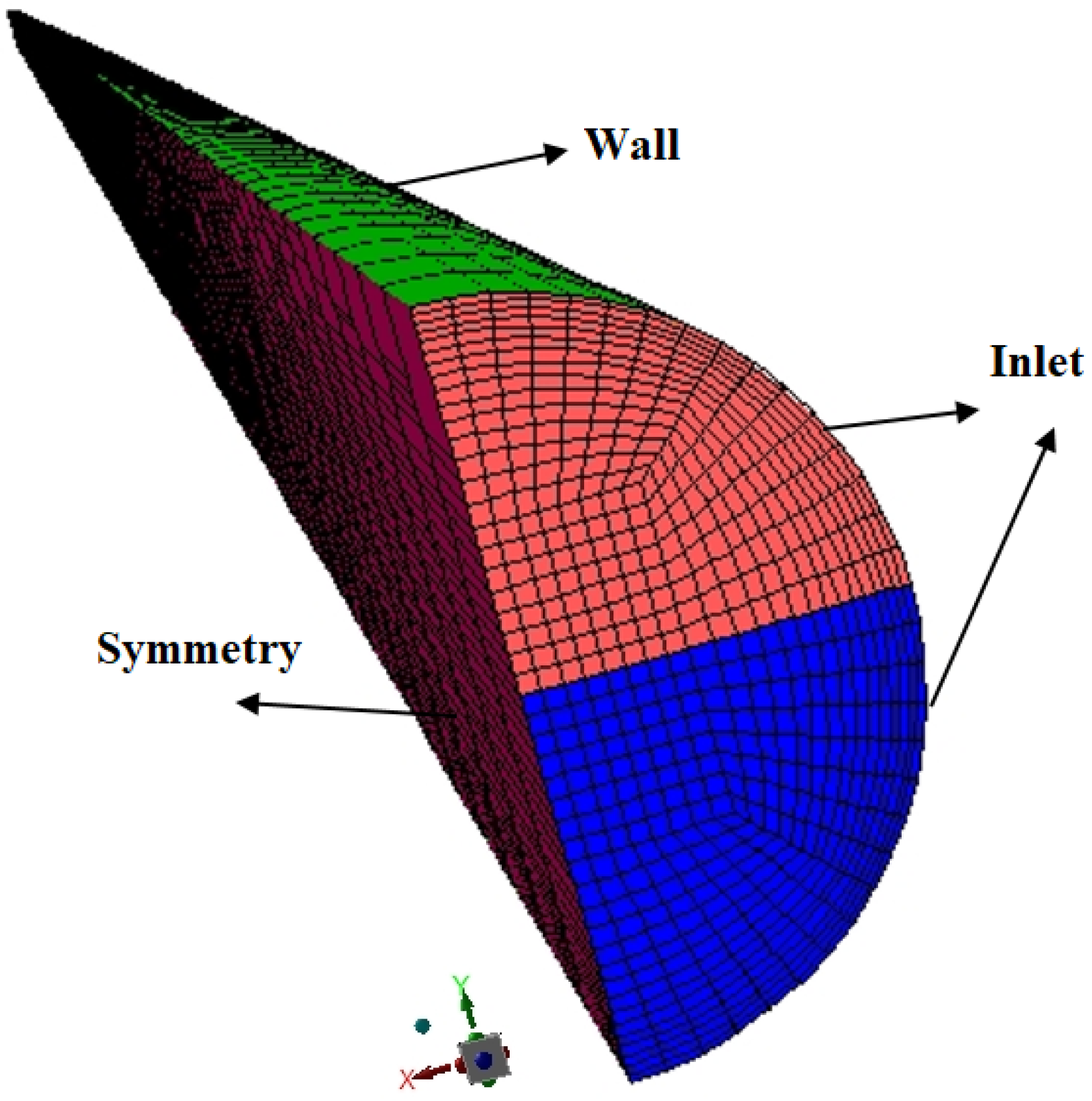
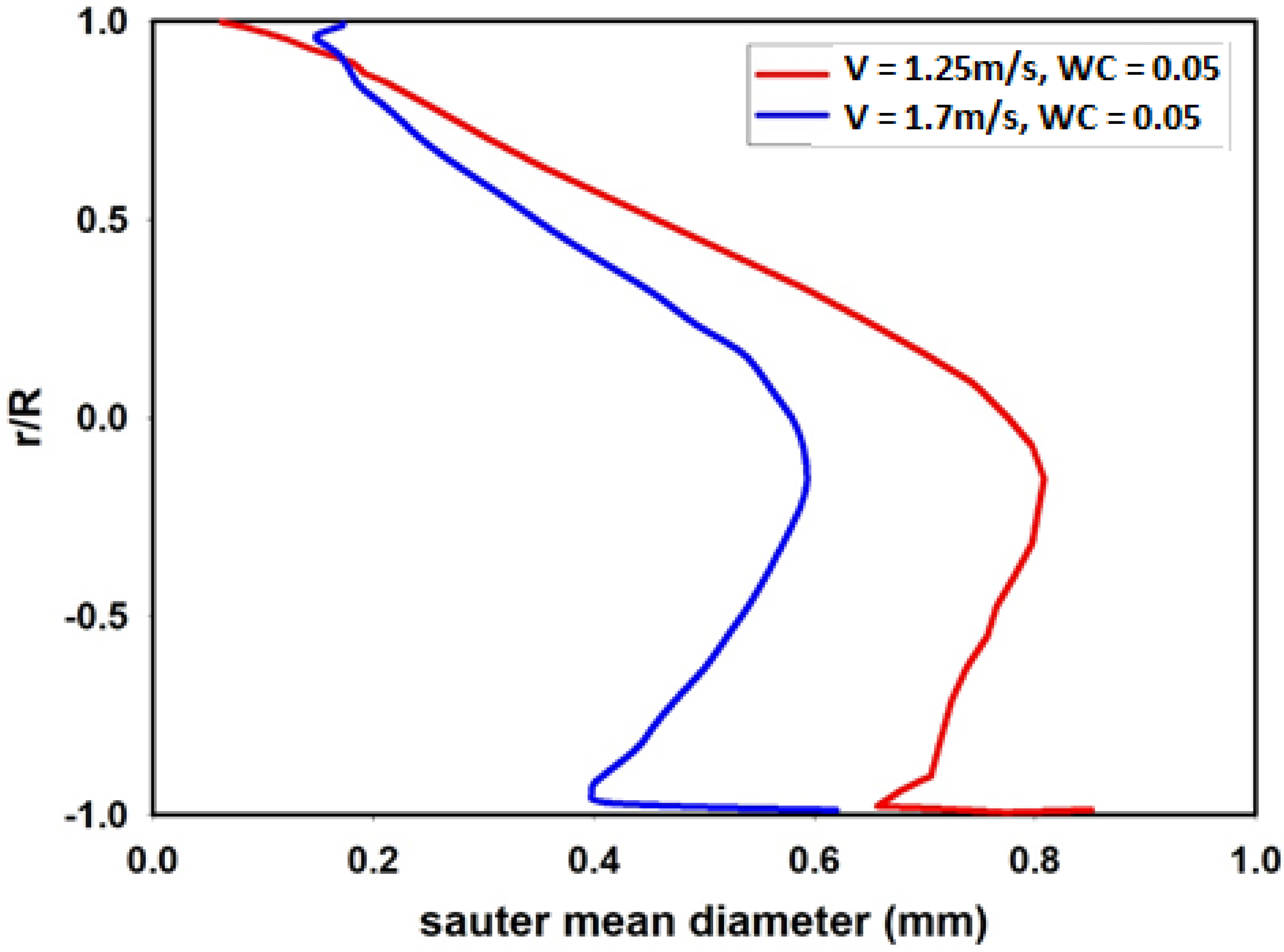
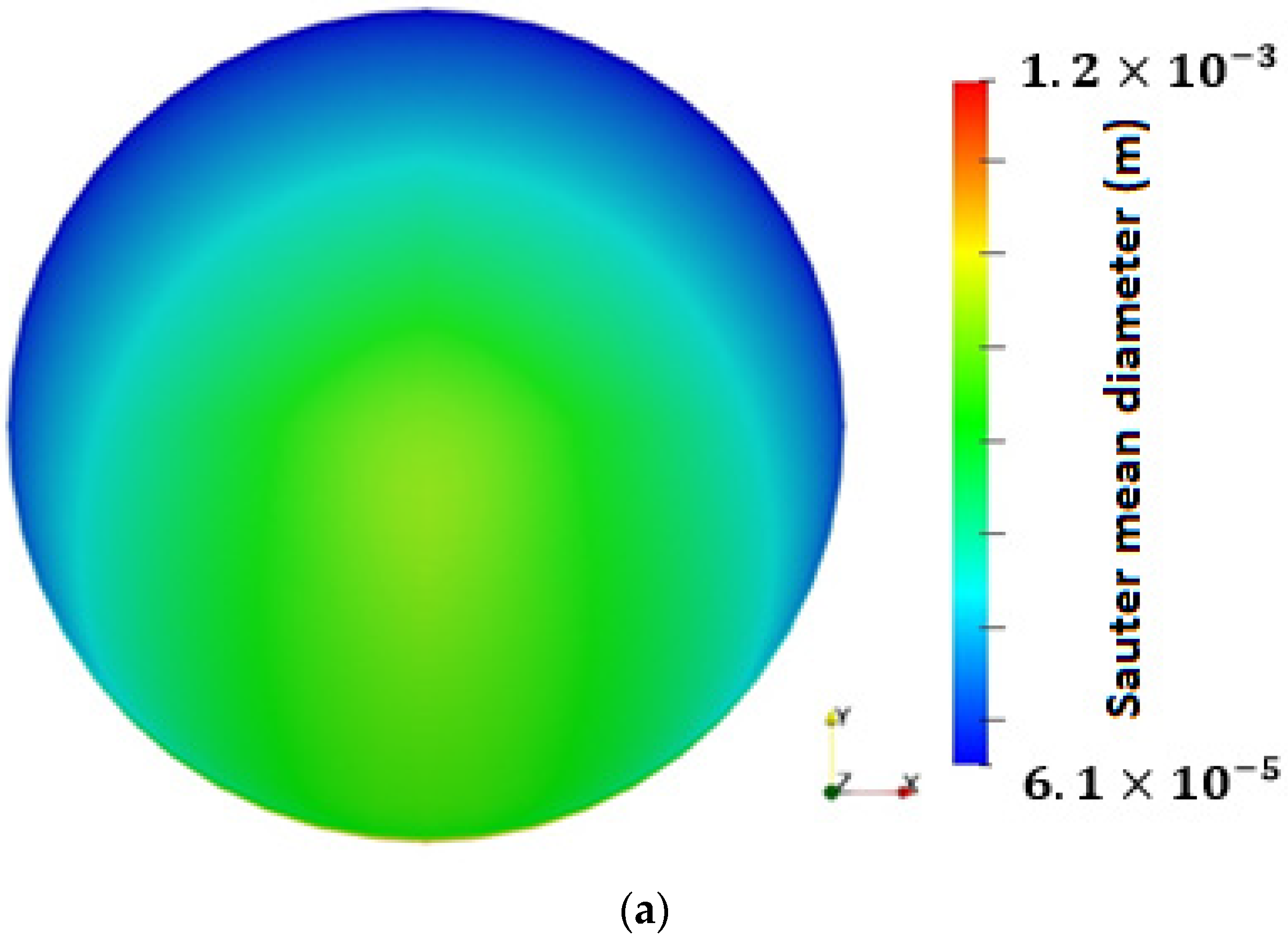
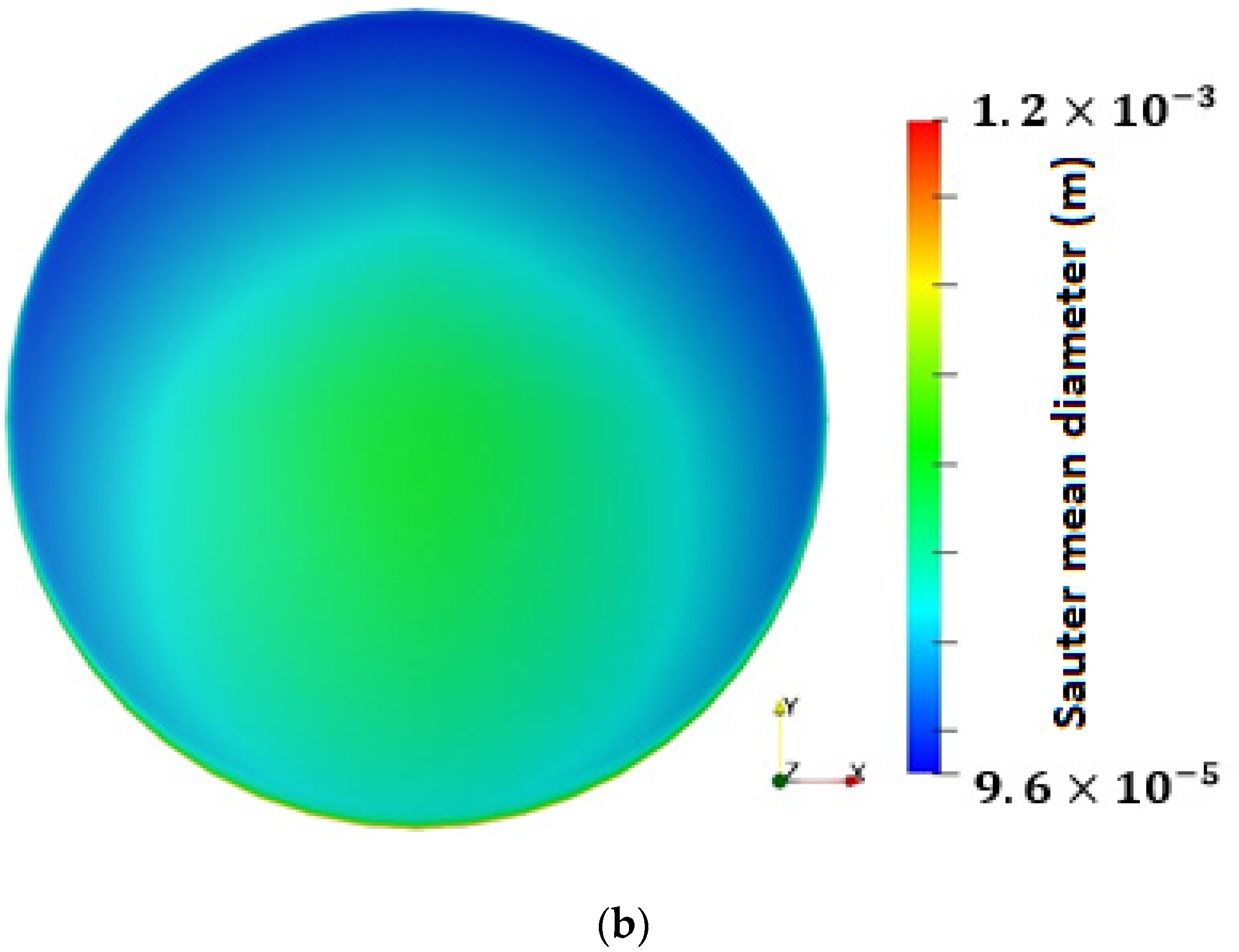
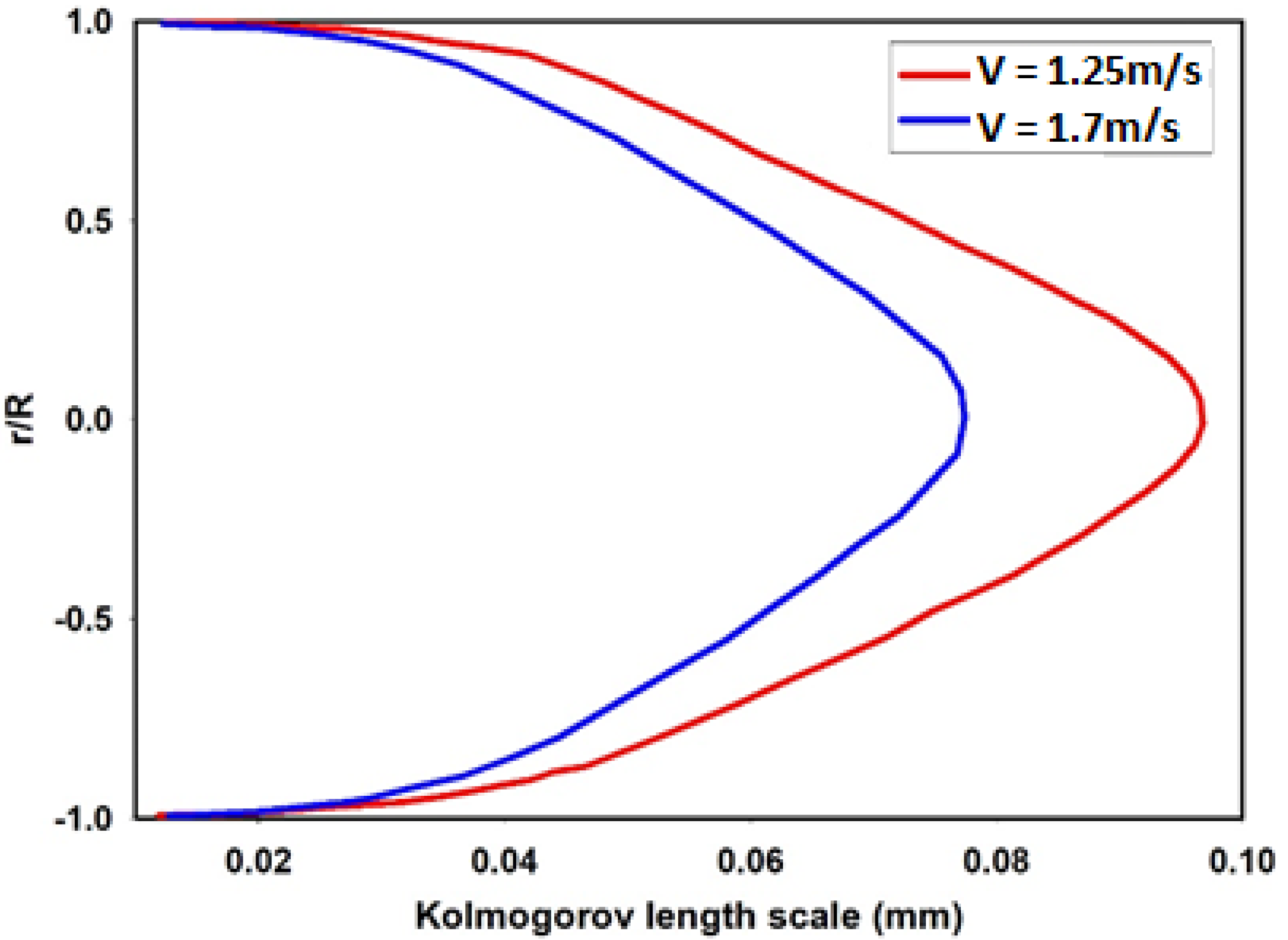

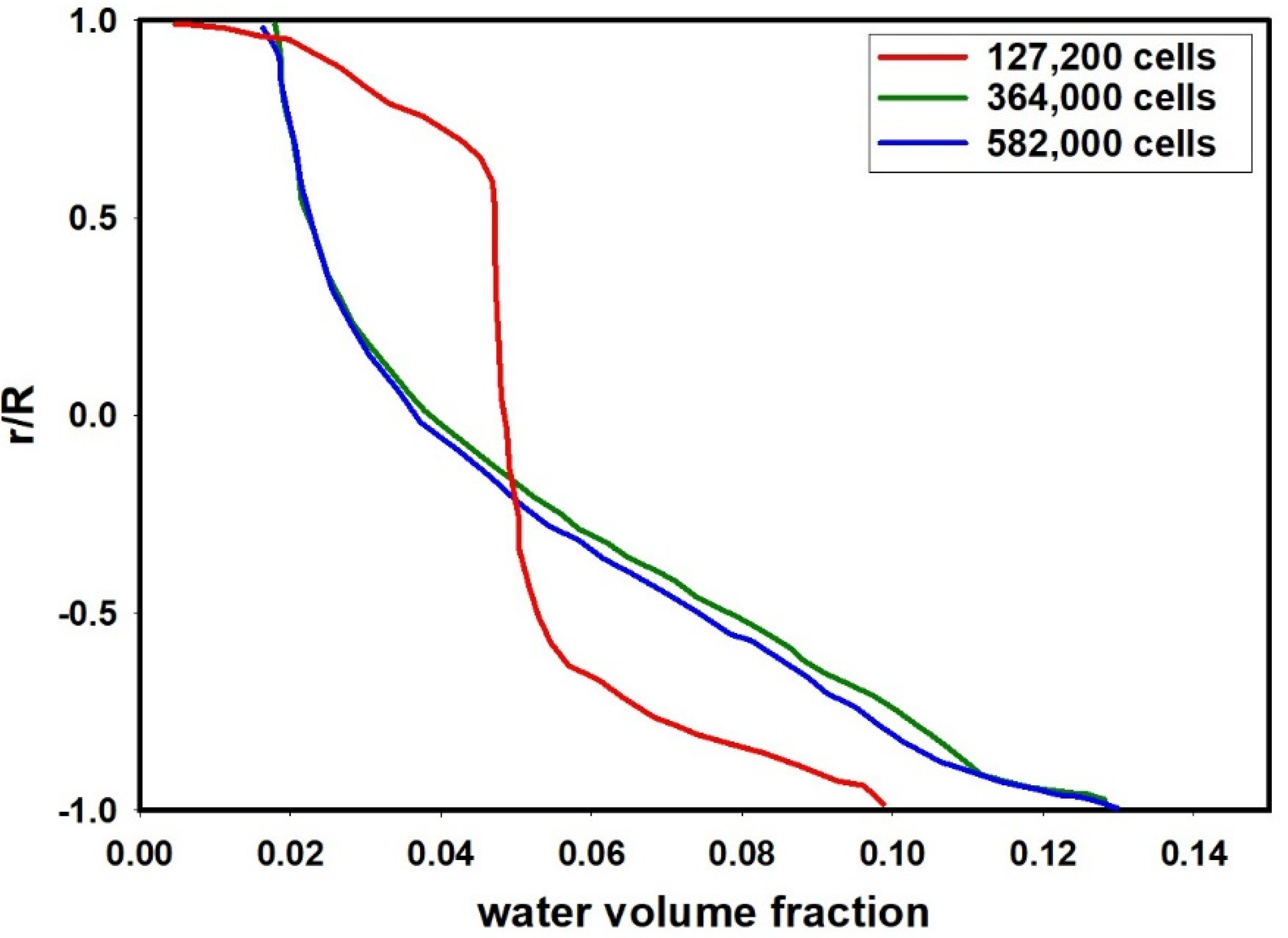
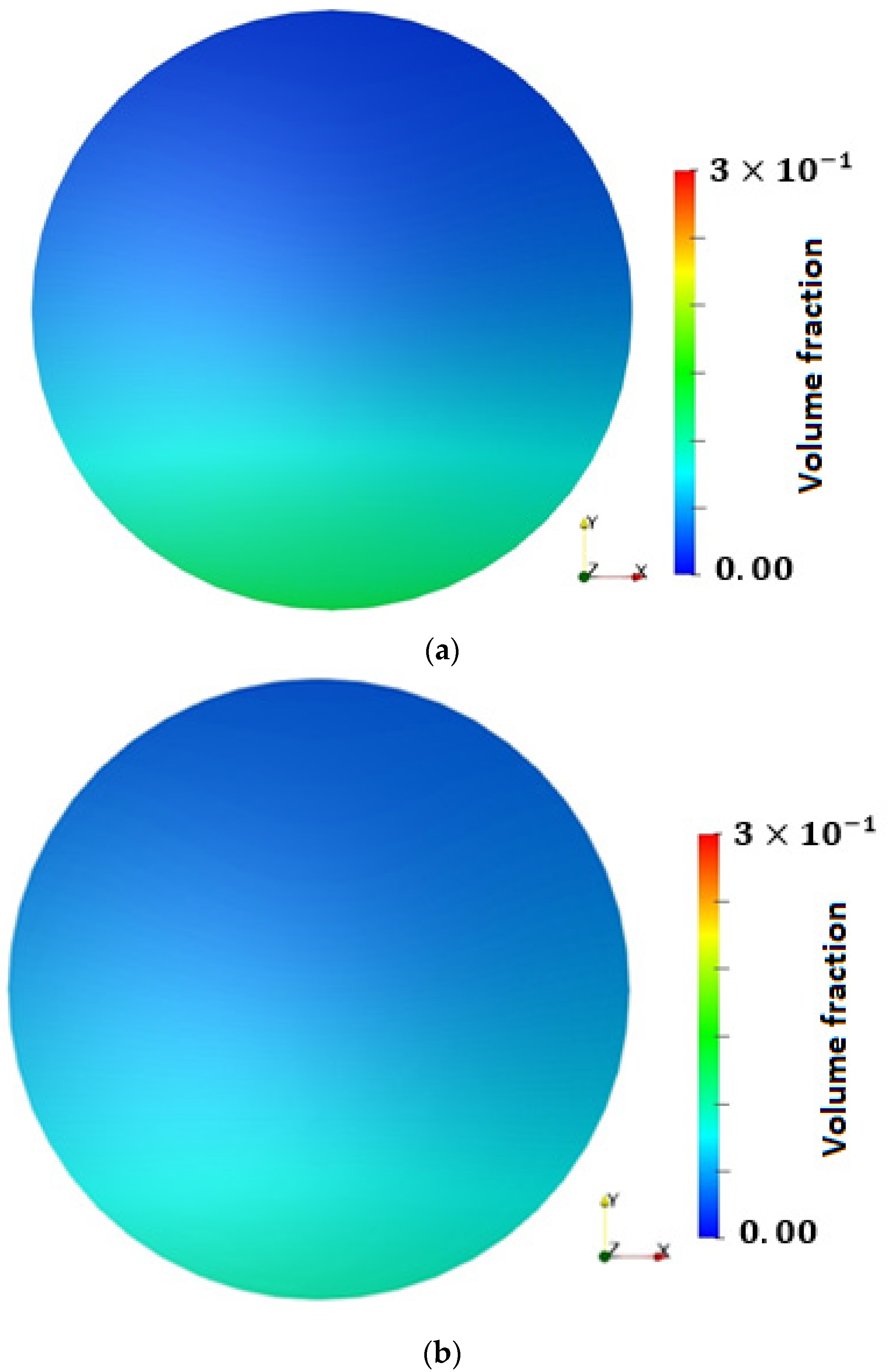
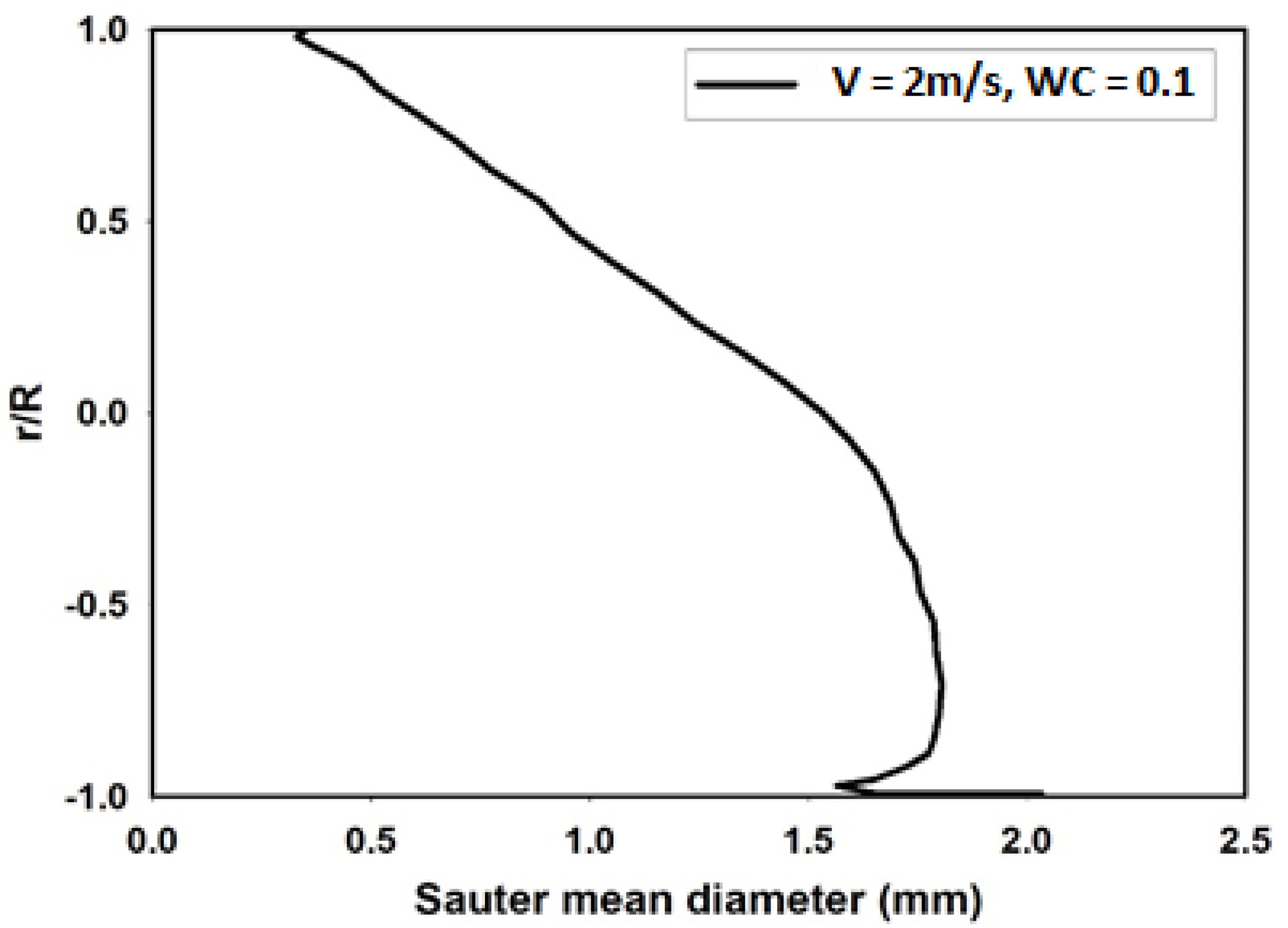
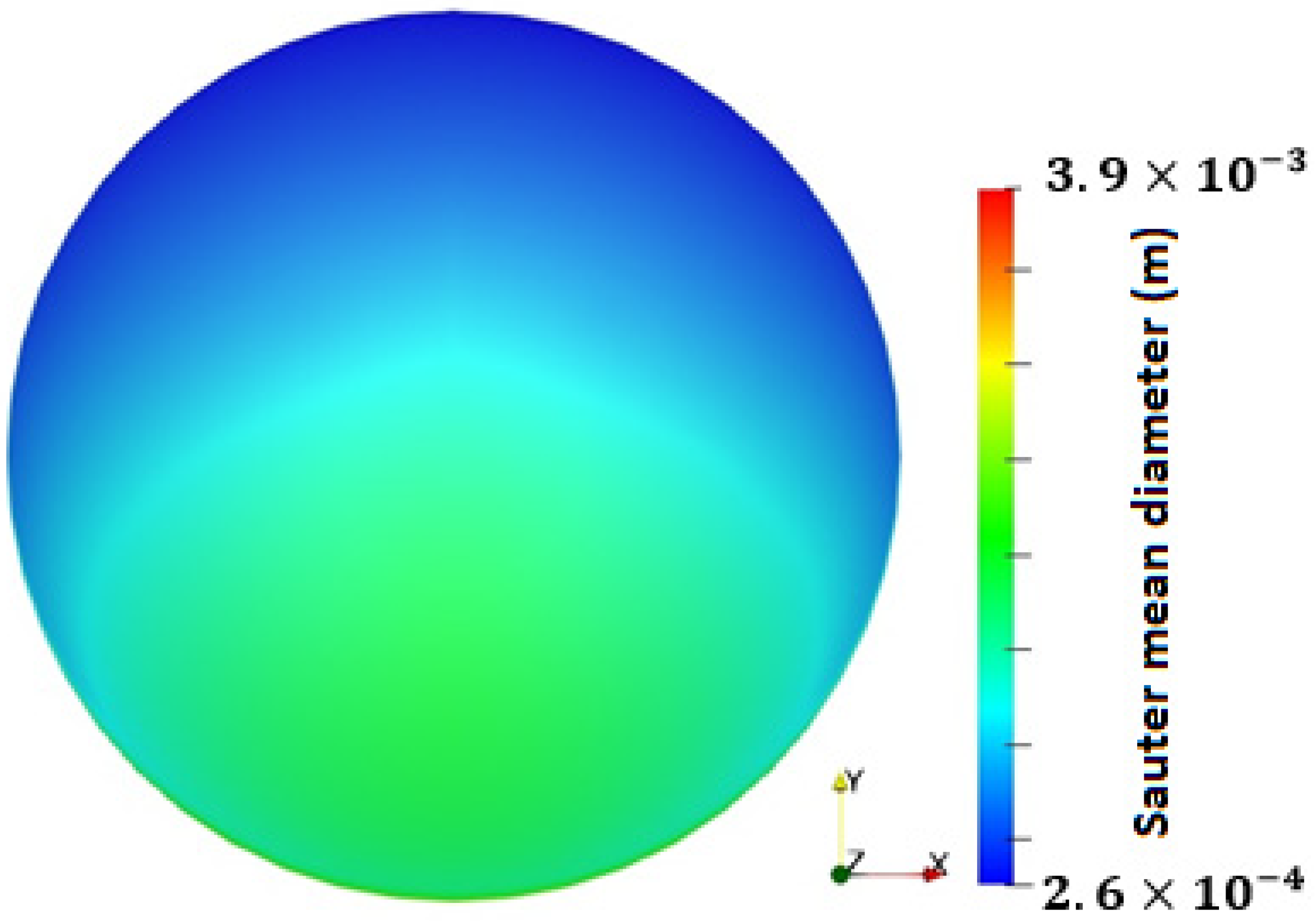
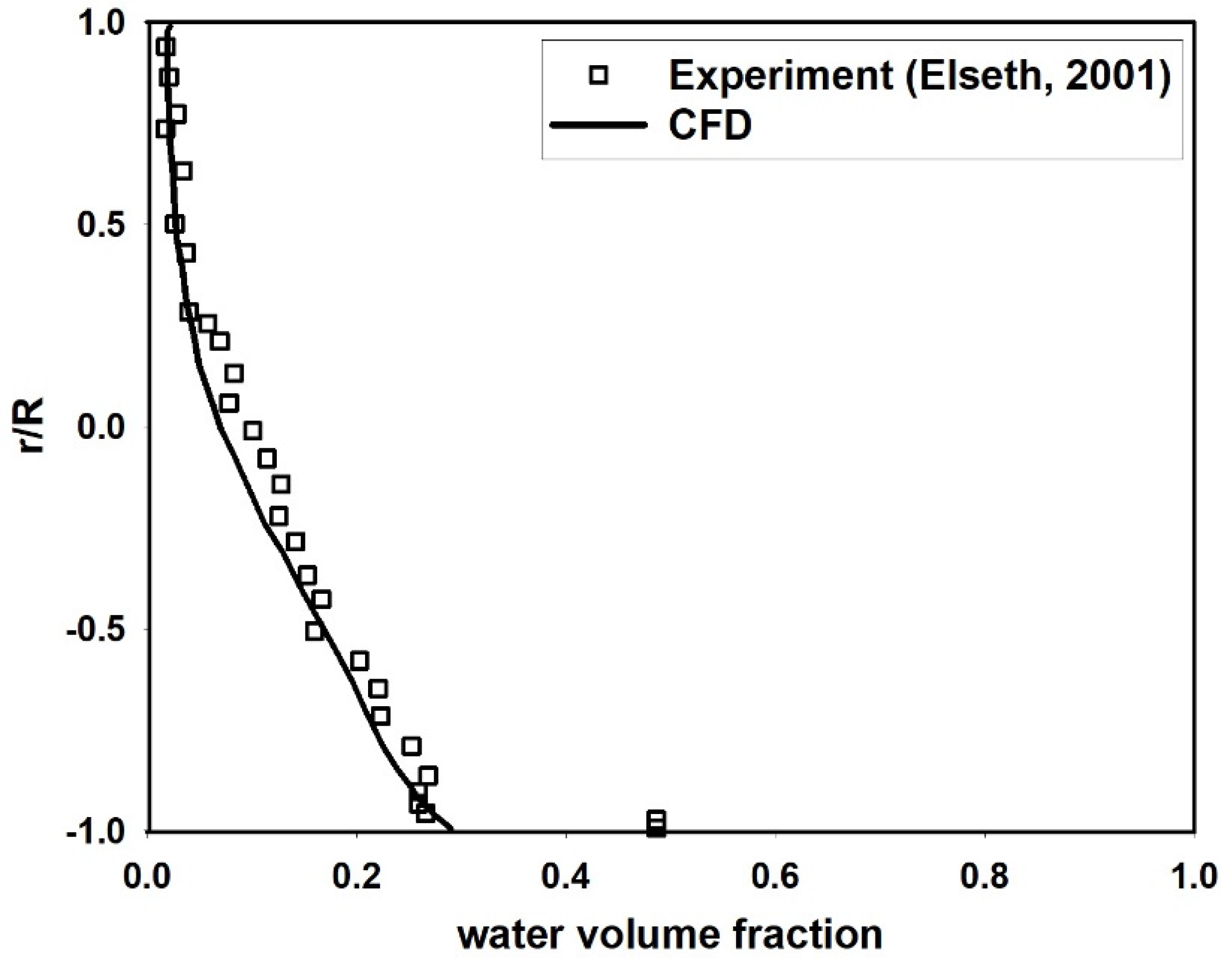
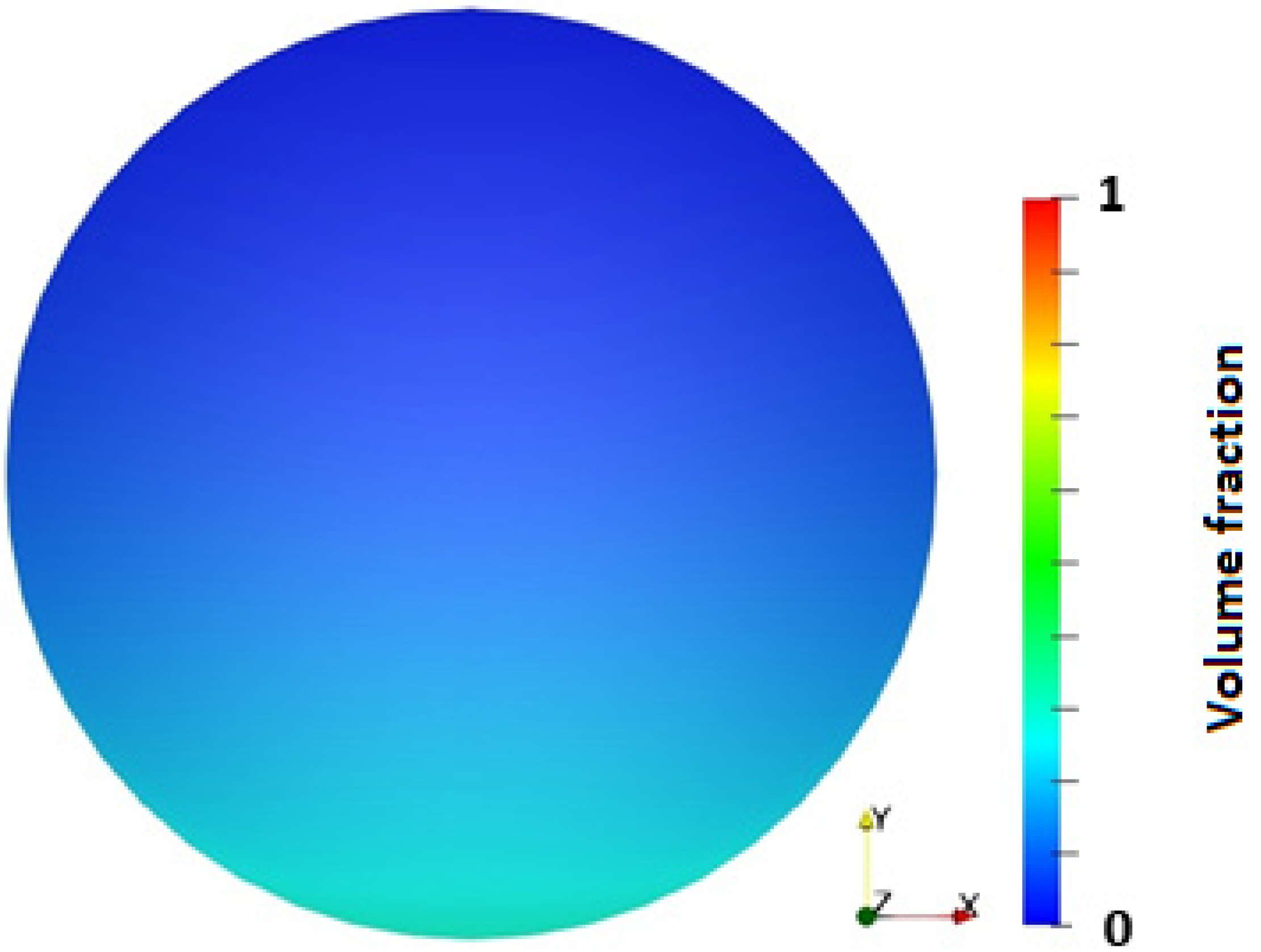

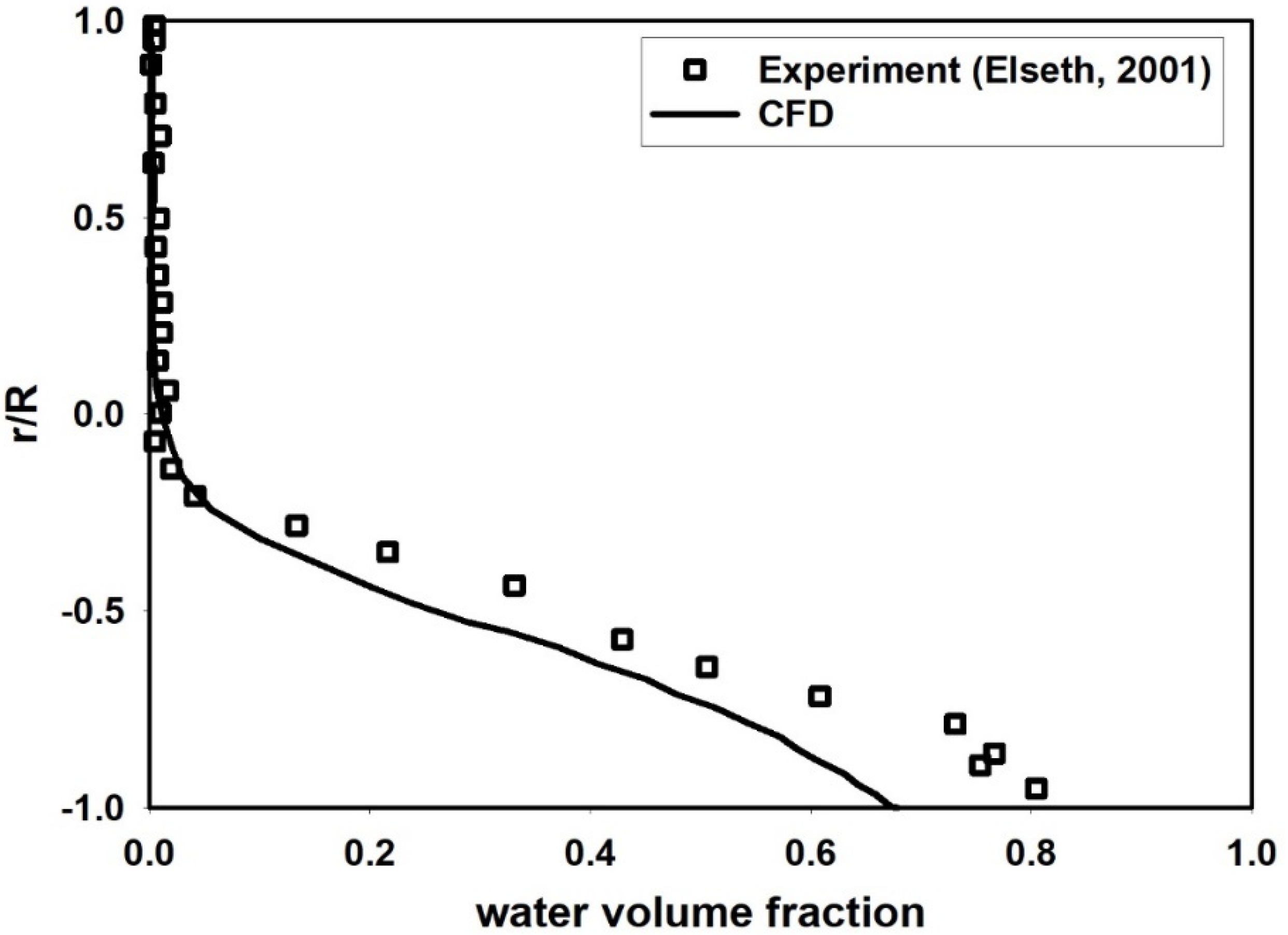

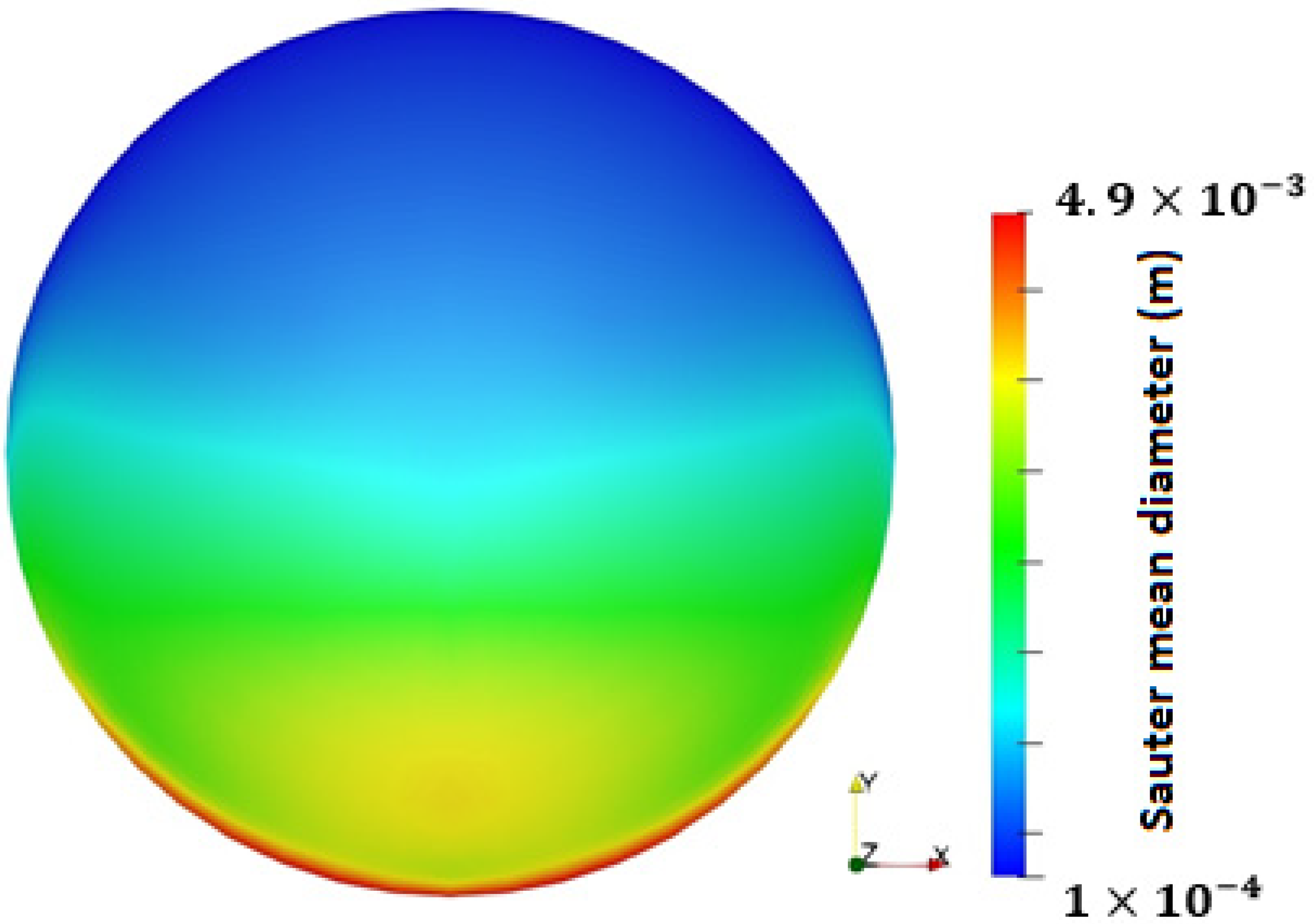
| Experimental Condition | Test 1 Angeli and Hewitt [52] | Test 2 Angeli and Hewitt [52] | Test 3 Elseth [72] | Test 4 Elseth [72] |
|---|---|---|---|---|
| Pipe diameter | 2.43 m | 2.43 m | 5.6 m | 5.63 m |
| Pipe length | 9.7 m | 9.7 m | 15 m | 15 m |
| Pipe roughness | 7 m | 7 m | 1 m | 1 m |
| Oil viscosity | 1.6 mPa·s | 1.6 mPa·s | 1.64 mPa·s | 1.64 mPa·s |
| Oil density | 8.01 Kg/m3 | 8.01 Kg/m3 | 7.9 Kg/m3 | 7.9 Kg/m3 |
| Flow velocity | 1.25 m/s | 1.7 m/s | 2 m/s | 1 m/s |
| Water cut | 5 | 5 | 1 | 1 |
| Interfacial tension | 1.7 N/m | 1.7 N/m | 4.3 N/m | 4.3 N/m |
| Experimental Condition | Sauter Mean Diameter 1.7 m/s | Sauter Mean Diameter 1.25 m/s |
|---|---|---|
| Measurement | 0.35 mm | 0.6mm |
| CFD-PBM | 0.456 mm | 0.665 mm |
Publisher’s Note: MDPI stays neutral with regard to jurisdictional claims in published maps and institutional affiliations. |
© 2021 by the authors. Licensee MDPI, Basel, Switzerland. This article is an open access article distributed under the terms and conditions of the Creative Commons Attribution (CC BY) license (https://creativecommons.org/licenses/by/4.0/).
Share and Cite
Pouraria, H.; Park, K.-H.; Seo, Y. Numerical Modelling of Dispersed Water in Oil Flows Using Eulerian-Eulerian Approach and Population Balance Model. Processes 2021, 9, 1345. https://doi.org/10.3390/pr9081345
Pouraria H, Park K-H, Seo Y. Numerical Modelling of Dispersed Water in Oil Flows Using Eulerian-Eulerian Approach and Population Balance Model. Processes. 2021; 9(8):1345. https://doi.org/10.3390/pr9081345
Chicago/Turabian StylePouraria, Hassan, Ki-Heum Park, and Yutaek Seo. 2021. "Numerical Modelling of Dispersed Water in Oil Flows Using Eulerian-Eulerian Approach and Population Balance Model" Processes 9, no. 8: 1345. https://doi.org/10.3390/pr9081345





